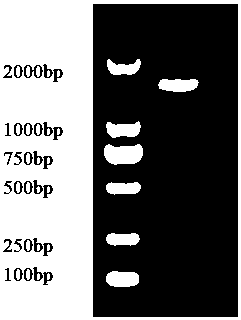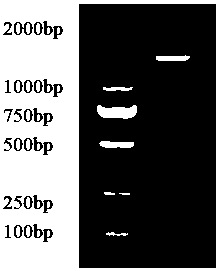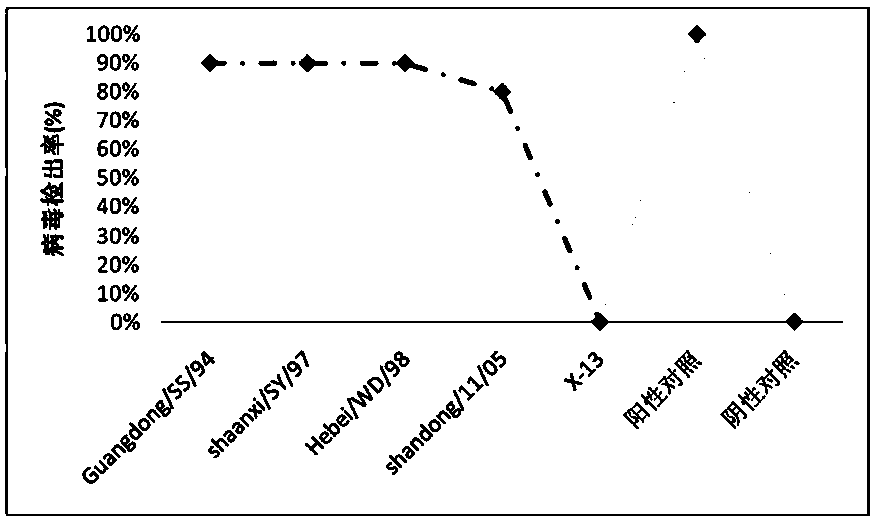H9 subtype lowly pathogenic avian influenza virus and application thereof
A bird flu virus, low pathogenicity technology, applied in the direction of antiviral agent, virus/phage, medical preparations containing active ingredients, etc., can solve the problems such as the decline of vaccine protection effect, and achieve the prevention of H9 subtype bird flu, good Effect of specificity and good immunogenicity
- Summary
- Abstract
- Description
- Claims
- Application Information
AI Technical Summary
Problems solved by technology
Method used
Image
Examples
Embodiment 1
[0029] Example 1: Isolation and Identification of H9 Subtype Avian Influenza Virus X-13 Strain
[0030] 1. Epidemiological investigation
[0031] Investigate the clinical manifestations, necropsy lesions and mortality of chicken flocks. In December 2010, a flock of Sanhuang broiler chickens in a large chicken farm in Xinzheng, Henan Province began to suffer from symptoms such as loss of appetite, depression, coughing, head shaking, sneezing, and difficulty breathing. The necropsy found that the affected chicken had obvious pathological changes in the respiratory system and digestive tract, severe congestion and hemorrhage in the tracheal ring, severe congestion and hemorrhage in the lungs, redness, swelling and hemorrhage in the lymph nodes of the small intestine, and enlargement of the liver and kidneys. Acute death occurred in some sick chickens, and the use of various antibiotics did not improve significantly.
[0032] 2. Collection and processing of disease materials
...
Embodiment 2
[0055] Embodiment 2: Preparation of H9 subtype avian influenza X-13 strain virus antigen
[0056] 1. Preparation of seed batches of H9 subtype avian influenza X-13 strain
[0057] Get the purified H9 subtype avian influenza X-13 strain with sterilized normal saline for 10 -4 Doubling dilution, inoculate 9-10 days old SPF chicken embryos, inoculate 0.1mL in the allantoic cavity of each chicken embryo, seal with wax after inoculation, incubate in a 37°C incubator, irradiate embryos once every 8h, remove dead chicken embryos within 24h, Observed to 96h. Harvest the allantoic fluid of chicken embryos in a sterilized container, and measure the hemagglutination value. Any chicken embryos with a titer lower than 7log2 should be discarded. At the same time for sterility test. The harvested virus liquid should be frozen below -30°C before inactivation, which should not exceed 3 months.
[0058] 2. Sterility test
[0059] According to "The Veterinary Pharmacopoeia of the People's R...
Embodiment 3
[0066] Embodiment 3: the immune effect of H9 subtype avian influenza X-13 strain
[0067] 1. Serological potency test
[0068] Fifty 7- to 10-day-old SPF chickens were randomly divided into two groups, 30 in the experimental group and 20 in the control group. The experimental group was subcutaneously injected with the vaccine in the neck, and the dose of immunization preparation was 0.3 mL, among which the dose of antigen was 75 μl. Blood was collected once before inoculation and once a week after inoculation until the fifth week. Blood was randomly collected from 5 mice in each group each time, the serum was separated, and the anti-avian influenza virus H9 subtype HI antibody was detected, and the geometric mean value was taken as the result. The HI detection results are shown in Table 3. The experimental group reached its peak 28 days after immunization, and then maintained at a high level.
[0069] Table 3 Serological potency test
[0070]
[0071] 3. Challenge cross...
PUM
 Login to View More
Login to View More Abstract
Description
Claims
Application Information
 Login to View More
Login to View More - R&D
- Intellectual Property
- Life Sciences
- Materials
- Tech Scout
- Unparalleled Data Quality
- Higher Quality Content
- 60% Fewer Hallucinations
Browse by: Latest US Patents, China's latest patents, Technical Efficacy Thesaurus, Application Domain, Technology Topic, Popular Technical Reports.
© 2025 PatSnap. All rights reserved.Legal|Privacy policy|Modern Slavery Act Transparency Statement|Sitemap|About US| Contact US: help@patsnap.com



